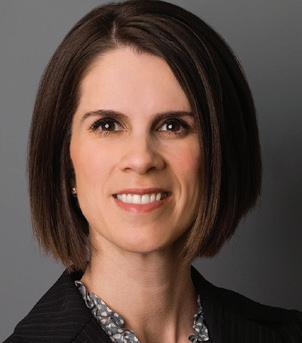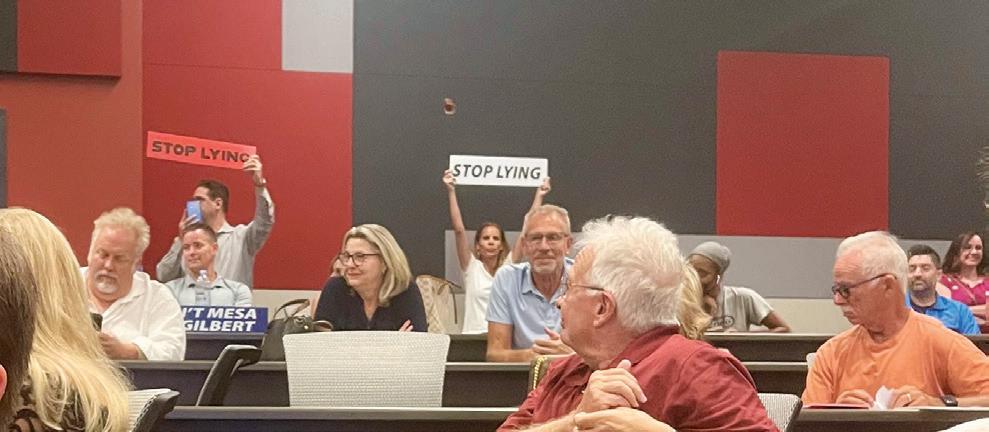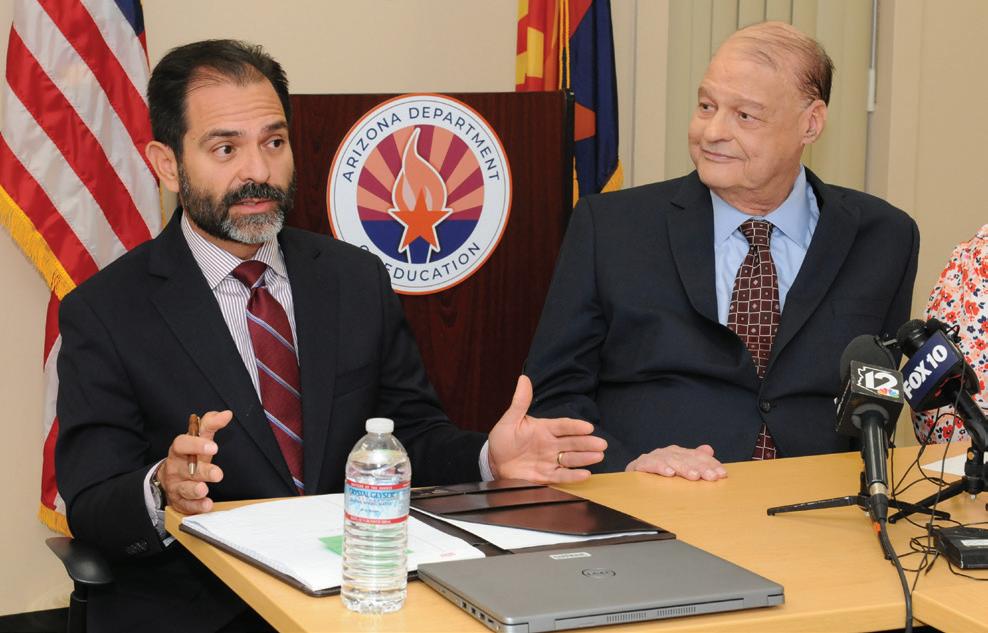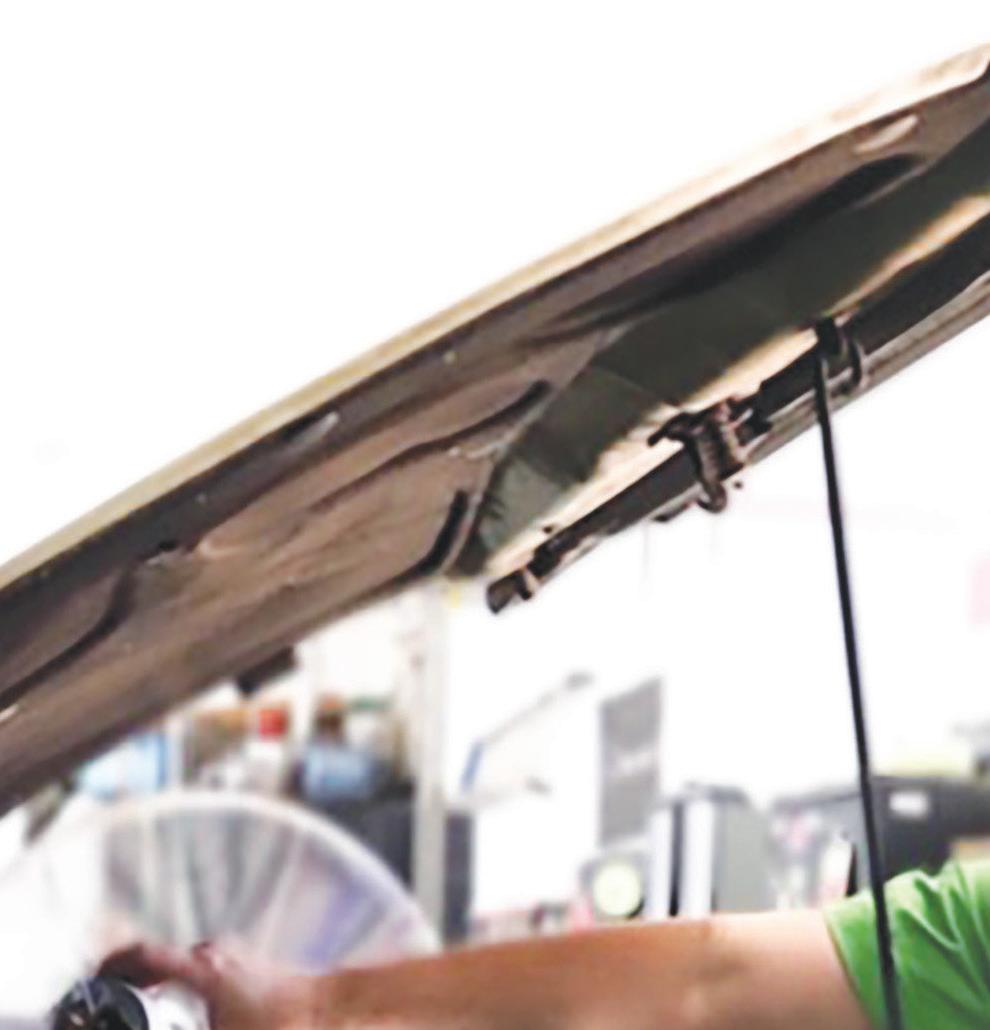










Nineteen-year-old Rachel Hansen was ready to begin the next chapter of her life – she was engaged to be married, had earned a real estate license and recently moved to a new Gilbert apartment.
On Rachel’s second day in her new home in the Redstone at San Tan Village, someone entered her apartment after midnight, shot her once while she was in bed and left. Rachel was later pronounced dead at Chandler Regional Medical Center.
Today marks the one-year anniversary of Rachel’s death. No suspect has been publicly identi ed
and “the investigation remains ongoing,” according to police.
“She was sleeping on her back,” Kim Hansen said of her daughter. “ e bullet went in the lower left abdomen and went out her top right shoulder.
“ ere’s some question if the main door was unlocked or someone had a key. But her bedroom door was shut because she had two pups in there she was fostering.”
In her 911 call at 2 a.m., Saturday, June 4, 2022, Rachel told Gilbert Police dispatch that she had been shot by a stranger in her apartment.
“ ey didn’t take anything,”
see RACHEL page 8

Town Council members returned to work last week after the Memorial Day break to find they’re being sued by three residents who were cast out of a public meeting nine months ago.
Dr. Brandon Ryff, Ryan Handelsman and Joanne Terry filed a federal lawsuit May 26 alleging their freedom of speech was violated when Mayor Brigette Peter-
son in a retaliatory move against her political opponents ordered police to remove them for silently holding signs at the back of council chambers. The entire council and the Town are named as defendants and were served last Wednesday.
Ryff also filed a state lawsuit against the council and the town, claiming the mayor and town “acted with actual malice in defaming” him.
“Gilbert was served at noon (Wednesday) and we have engaged outside coun-
sel to review and defend the Town in litigation,” spokeswoman Jennifer Harrison said in an email. “Due to the litigation, the Town will not be commenting further.”
The two suits were preceded by claims for damages that were deemed denied because Gilbert officials took no action within the 60-day time limit.
“The mayor targeting and violating the constitutional rights of residents she dis-
see SUITS page 14

















“Did your new hearing aids cost much?” inquired a friend.
“Well,” said the new hearing aid user as she drew a deep breath.” my hearing loss cost me three friendships that I know of, a strained relationship with my husband, two grandchildren who think I don’t understand them, boredom at church, and lost interest in attending get-togethers.”
After a reflective pause, she added: “Sure I invested some money to get these hearing aids... but it doesn’t compare with what it cost before I got them.”





CONTACT INFORMATION
Main number: 480-898-6500 | Advertising: 480-898-6559
Circulation service: 480-898-5641
Publisher: Steve T. Strickbine
Vice President: Michael Hiatt
ADVERTISING DEPARTMENT
Display Advertising: 480-898-6309
Classifieds/Inside Sales:
480-898-6500 | classi eds@timeslocalmedia.com
TJ Higgins | 480-898-5902 tjhiggins@timeslocalmedia.com
Steve Insalaco |480-898-5635 sinsalaco@timeslocalmedia.com
Advertising Sales Executive: Jane Meyer | 480-898-5633 jane@timeslocalmedia.com
NEWS DEPARTMENT
Executive Editor: Paul Maryniak | 480-898-5647 pmaryniak@timeslocalmedia.com
Managing Editor: Cecilia Chan | 480-898-5613 cchan@timeslocalmedia.com
Reporters: Ken Sain | 928-420-5341 ksain@timeslocalmedia.com
Get Out Editor: Christina Fuoco-Karasinski | 480-898-5631 christina@timeslocalmedia.com
Sports Editor: Zach Alvira | 480-898-5630 zalvira@timeslocalmedia.com
Photographer:
Dave Minton | dminton@timeslocalmedia.com
Design:
Veronica Thurman | vthurman@timeslocalmedia.com
Design/Production Supervisor
Courtney Oldham | production@timeslocalmedia.com
Circulation Director: Aaron Kolodny | aaron@phoenix.org
David Butkay and Daniel Garcia have the quickest hands in the Valley when it comes to re-assembling a 250-pound fire hydrant.
Butkay and Garcia, both senior utility technicians for the Town of Gilbert, beat out other teams last month in the annual Hydrant Hysteria competition with a time of 1 minute and 18 seconds.
Gilbert has placed second in previous competitions but this is the first year the team has come in first, according to the Water Manager Rebecca Hamel.
The duo will now do battle for the championship title at the American Water Works Association’s Conference in Toronto, Canada in mid-June.
“We practiced for about a month – a couple of hours, three days out of the week,” said Garcia. “Our initial time was 2 minutes and we were able to get it down to 1:08. While we were hoping to get 1:10 we were happy to win.”
Garcia said he had “tears of joy” when his team was announced the winner.
It was Garcia’s first time entering the fast-paced timed challenge but he paired with a veteran, Butkay, who’s competed three previous times.
Garcia said the two trained solely on the Clow Medallion hydrant, the model used in this year’s competition.
Sponsoring manufacturers and the Hydrant Hysteria Subcommittee determine the yearly hydrant featured. A total of 10 teams competed in May.
“The Clow Medallion has less parts and is the easiest,” Garcia said. “The hardest is M & H due to have more parts.”
He said that five different types of hydrants are used in the town but that the Clow Medallion is the one most typically used.
The competition is tough.
Each team is given the tools they would need to put together a fire hydrant that’s been totally disassembled down to the lower barrel and shoe.
Members of the two-person teams

each have a role – one would assemble the top parts and the other the lower parts and “they meet together when tightening the last bolt,” according to Garcia.
There are three judges per hydrant, a timing judge, an umpire who checks all the bolts and caps are tighten by a hydrant wrench and an operations judge who tests the hydrant and confirms it’s assembled correctly.
They also watch for safety violations and any flagrant violations are penalized by adding time to the competitor’s raw time.
The penalty list is long and includes added time for throwing tools, hydrant parts not assembled correctly, loose or missing hydrant bolt or caps, tools placed in pockets before or after the start of the event and hand tightening.
The mistake that will disqualify a
team is if the hydrant fails to operate correctly.
Helping the Gilbert team with its trophy win was coach Josh Robertson, utility worker II.
Robertson said he kept the team focused while practicing and kept track of overall times.
He also worked with Butkay and Garcia individually to “minimize wasted movements and improve muscle memory to complete the hydrant in the shortest time possible.”
“They work very well together and utilize each other’s strengths,” Robertson said. “If one has an issue with a part during assembly, the other one compensates by stepping in to help in another assembly step.”
He said his game plan heading to the





Valor Christian Center last week was exploring other zoning options that would allow it to have a much taller and bigger sign than the one currently sitting on its 6-acre Gilbert site. is comes on the heels of the church losing its appeal of the Town’s denial for the larger electronic messaging sign along Warner Road near homes.
“We’re probably not going to appeal to the Superior Court,” the Rev. Scott Whitwam said May 31. “What we are looking at potentially is other zoning options.”
Whitwam said the church’s application for a rezone to neighborhood commercial was still on the table and would allow for the sign by right but would require the church to scale back its building coverage on the land.
e pastor said the church was in no rush to make a decision and has until November to decide if it wants to move for-

ward with the neighborhood commercial rezone or cancel it.
“ e Town told us we are approved if we were willing to take the restrictions,” Whitwam said. “Our attorney found other zoning options.”
Valor Christian currently has a 5-foottall, 22-square-foot monument sign and requested to replace that with a 14-foot-




high, 64-square-foot sign with electronic messaging on both sides. It later agreed to a 12-foot-high sign with a 60-square-foot sign area.
Under its current residential zoning the church is allowed to have an 8-foot tall sign with a 32-square-foot electronic changing messaging display.
e Planning Commission, acting as the Board of Adjustment, voted 6-0 on May 24 to uphold the hearing o cer’s March decision to reject the church’s request for a variance to Gilbert’s Land Development Code or LDC.
“What’s concerning to me is I don’t want to be setting a precedent approving a variance for a sign of potentially this size and magnitude in a residential district,” board member Anthony Bianchi said Bianchi said that the church has the option under its current zoning to erect up to four signs – three on Warner Road and one on Claiborne Avenue, its entrance – at a maximum height of 8 feet and 32 square feet of sign area each.
“We’ve also seen that there’s been examples that have been documented with similar type uses in similar zoning districts around the town that are still within town code and the LDC and the sign code,” Bianchi added. “ e ndings haven’t been met for me to reverse course on the variant.”
Attorney Erik Stanley, however, argued that the church met all four town provisions for the variance.
One of the special circumstances is the church building’s location on the site and
the surroundings deprive it of the same visibility and being as noticed as other houses of worship in residential zones in Gilbert, according to Stanley.
He said it was important to note that the church has been at the location since 2008 and is closer to Claiborne than Warner. e church’s site plan was made at the time when the area was farm elds.
“At the same time the church building was built, Warner Road was a two-lane road, the speed limit ranged from 25 to 35 mph,” Stanley said. “ e town has literally kind of grown up around the church.”
“Warner Road is now a divided six-lane highway or six-lane road with a 45 mph speed limit. So the surroundings of the property here were changed not by the church. e church didn’t do anything and it’s been the same since 2008 but by the widening of the road and the town kind of growing up around the church (makes) it more di cult for the signs to be seen.”
He said the current monument sign, which is low to the ground, is di cult to catch the eyes of motorists as they drive by at 50 mph.
According to Stanley, the church originally pursued a rezoning to neighborhood commercial and would have been able to have the taller and larger sign by right.
But by doing so, it would have to limit its future building coverage to 25,000 square feet. e church’s original approved master plan allowed up to 42,000 square feet.
“So, the church said, ‘Well it doesn’t seem to make a whole lot of sense,’” Stanley said. “Literally nothing on the property would change with the rezoning other than the letter that you see. Instead of SF8, it would be NC.
He said the larger sign also is allowed for the public storage facility east of the church. e other three sides of the church property are surrounded by houses.
He said the nine churches in residential areas cited by town sta for not asking for sign variances can’t be compared with Valor Christian because their properties

Mesa, AZ - When it comes to chronic pain and/ or neuropathy, the most common doctor-prescribed treatment is drugs like Gabapentin, Lyrica, Cymbalta, and Neurontin. The problem with anti-depressants or anti-seizure medications like these is that they offer purely symptomatic relief, as opposed to targeting and treating the root of the problem. Worse, these drugs often trigger an onset of uncomfortable, painful, and sometimes harmful side effects.
The only way to effectively treat chronic pain and/or peripheral neuropathy is by targeting the source, which is the result of nerve damage owing to inadequate blood flow to the nerves in the hands and feet. This often causes weakness and numbness.

As displayed in figure 1 above, the nerves are surrounded by diseased, withered blood vessels. A lack of sufficient nutrients means the nerves cannot survive, and thus, slowly die. This leads to those painful and frustrating consequences we were talking about earlier, like weakness, numbness, tingling, balance issues, and perhaps even a burning sensation.
The drugs your doctor might prescribe will temporarily conceal the problems, putting a “BandAid” over a situation that will only continue to deteriorate without further action.
Thankfully, Mesa is the birthplace of a brand new facility that sheds light on this pressing problem of peripheral neuropathy and chronic pain. The company is trailblazing the medical industry by replacing outdated drugs and symptomatic reprieves with an advanced machine that targets the root of the problem at hand.

Effective neuropathy treatment relies on the following three factors:
1. Finding the underlying cause
2. Determining the extent of the nerve damage
(above 95% nerve loss is rarely treatable)
3. The amount of treatment required for the patient’s unique condition
Aspen Medical in Mesa, AZ uses a state-ofthe-art electric cell signaling systems worth $100,000.00. This ground-breaking treatment is engineered to achieve the following, accompanied by advanced diagnostics and a basic skin biopsy to accurately analyze results:
1. Increases blood flow
2. Stimulates and strengthens small fiber nerves
3. Improves brain-based pain
The treatment works by delivering energy to the affected area(s) at varying wavelengths, from low- to middle-frequency signals, while also using Amplitude Modulated (AM) and Frequency Modulated (FM) signaling.
It’s completely painless!
THE GREAT NEWS IS THAT THIS TREATMENT IS COVERED BY MEDICARE, MEDICAID, AND MOST INSURANCES!!
Depending on your coverage, your peripheral neuropathy treatment could cost almost nothing – or be absolutely free.
The number of treatments required varies from patient to patient, and can only be determined following an in-depth neurological and vascular examination. As long as you have less them 95% nerve damage, there is hope!
Aspen Medical begins by analyzing the extent of the nerve damage – a complimentary service for your friends and family. Each exam comprises a detailed sensory evaluation, extensive peripheral vascular testing, and comprehensive analysis of neuropathy findings.
Aspen Medical will be offering this free chronic pain and neuropathy severity evaluation will be available until June 30th, 2023. Call (480) 2743157 to make an appointment.
Due to our very busy office schedule, we are limiting this offer to the first 10 callers. YOU DO NOT HAVE TO SUFFER ANOTHER MINUTE, CALL (480) 274-3157...NOW!!
We are extremely busy, so we are unavailable, please leave a voice message and we will get back to you as soon as possible.
Hansen said. “Nothing was stolen, nothing was missing.”
A resident living at the complex noted she heard no noise from Rachel’s apartment.
“My apartment is wall-to-wall with hers and it breaks my heart that we didn’t hear anything and therefore didn’t call for help,” she said.
“We had no idea anything had happened until police banged on our door. According to what I’ve heard from others, the people below her didn’t hear anything either. I have no clue how nobody in our building was able to hear any of it.”
Hansen is no closer today than in 2022 in learning who killed Rachel and “absolutely can’t imagine” who would want to do so.
“She didn’t have any enemies,” Hansen said. “She didn’t have any bad things going on in life. She did not use drugs.
“I wonder if it was the wrong place at the wrong time. I can’t imagine anybody intentionally taking her life at all.”
Upon news of Rachel’s death, tributes poured in on social media with comments like “motivated, sweet, precious and nice.”
Even one woman who didn’t know Rachel but lived in the apartment downstairs felt compelled to comment.

“I’ve been heartbroken since 6/5,” she wrote. “I’ve heard how great she was here, I can only imagine the angel she is now.”
Hansen described Rachel as “strongwilled and determined and just so giving.”
She was always raising money, supplies or support for a cause, Hansen said.
“When she was young, 10 years old, she would take her wagon and walk around the block and go to neighbors to ask for food donations,” Hansen recalled. “She helped with several barrel races (and) auctioned items for a friend of hers with a serious medical condition. She was always going above and beyond to supporting causes of people she loved.”
Rachel’s early years
Rachel arrived at the Hansen Family’s home on an acre lot as a 6-year-old foster child with “lot of early childhood trauma,” according to Hansen.
One day while Rachel was sitting on the fence, she remarked, “I just wish we could have a horse.”
“We went back into the horse business for her and she ourished,” Hansen said. “ at is one of the best therapies for kids with very traumatic experiences – to learn to love and care for another living creature.”
Before Rachel joined the family, Hansel had sold and re-homed four horses because the older children were married or o to college. Kim and husband Todd have 13 other kids, most of whom they adopted.
e couple adopted Rachel three months after her arrival.
e horse whisperer
Although Rachel never had lessons in horse riding and training, she quickly became an accomplished equestrian and was well-known in that community.
“She had a natural gift,” Hansen said. “She was very good with horses. She never met a horse she couldn’t get on.
“She scared me all the time. I would hold my breath and she would call me and say, ‘mom, I’m going to ride the yearling, pray for me.’ She was so brave and so determined.”
At 14, Rachel began giving lessons to younger kids. At 16 after graduating from high school a year early, she started her own business of training, riding, hauling,


selling and nding horses for clients. She also rescued abandoned horses and she saved wild mustangs on federal land by training and re-homing them, according to Hansen.
At the time of Rachel’s death, her registered quarter horse, Dash, was in foal. Today, the mare and her baby live on the property dubbed “Hansen Ranch.”
Rachel’s death
Hansen said she was in Indiana babysitting two grandchildren when she learned of Rachel’s murder.
“My husband woke up to two Gilbert Police officers knocking on the front door and said, ‘Are you Rachel’s dad? Can we come in and talk to you?’ and told him what had happened,” Hansen recalled. “And then he called me in Indiana to tell me I had to quick as I
could get a flight home.”
Rachel was killed eight days before her 20th birthday, which was June 12. She was going to celebrate with her family at her favorite place – Canyon Lake where she would go tubing, skiing, diving o the board and cli jumping.
Besides horses, Rachel also loved wrestling soccer and she was the only girl on the football team in the 8th grade, according to her family.
Rachel was set to marry her nance Jomet Bailey in the fall and she planned to use her newly acquired real estate license to sell horse properties to people who wanted that kind of lifestyle, according to Hansen.
“ e rst six months after we lost her, there were days I didn’t even know what
10











While a Colorado River conservation plan has yet to be approved by the federal government, Gov. Katie Hobbs made two things clear two weeks ago: Arizona will lead the way in the tri-state agreement and Arizonans need not worry about a water-use crackdown. e governor’s news conference came days after Arizona, California and Nevada agreed to conserve 3 million acre-feet of Colorado River water by 2026.
“Whether you are a new parent worried about the future of your child, a business owner concerned about the sustainability of our economy, or a student who just wants the government to take climate change seriously, Arizona is taking action,” Hobbs said. “I look forward to Arizona leading the way in continuing to build an
But last week, state water o cials said they won’t issue any permits for new subdivisions for some areas on the fringes of Phoenix, the rst real acknowledgment that the state’s water supply cannot support all of the anticipated growth.
Tom Buschatzke, the director of the Department of Water Resources, said a newly completed analysis of the groundwater in the basin in and around Phoenix shows there simply won’t be enough to provide the legally required 100-year supply of water. State law requires such assurances in the major metropolitan areas.
But nothing in the new order will bring development to a halt – at least not in much of the Phoenix area.
Tom Buschatzke, the Arizona Department of Water Resources director, said
see WATER page 12
RACHEL from page 8
day it was,” Hansen said. “A couple of our kids went to therapy. I did for a short time.
“We took in her ancé, he stayed with us three months. He felt closest to Rachel being here.”
Although Bailey no longer lives with the Hansens, he stops over nearly every day to have dinner with the family.
“He’s part of our family,” Hansen said. “We love him as a son.”
Although it’s been a full year with no arrest, Hansen said she is “very optimistic” that the police will close the case.
“We do meet with the detective every couple of months,” she said. “He kinds of says, ‘We are working on it, we done some things. We go down one rabbit hole and something else pops up.’
“ ey have been following a couple of di erent leads but that is all they can tell us. ey don’t want anything to get out.
“I think it’s going to take some time. And we are just continuing to keep her story alive and known and out there so
that people don’t forget about it. I want people to be aware. We think of Gilbert as a safe community and yet this tragic thing happened.”
Although her daughter is gone, Rachel’s legacy continues on with the creation of a nonpro t animal rescue.
Hansen in May began setting up a nonpro t dog and puppy rescue called Rachel’s Rescue.
“Rachel fostered and cared for dogs and puppies with me,” Hansen said. “And she always wanted to start a rescue.”
With the anniversary of Rachel’s murder, Hansen said what really stood out for her was the mass shooting of 19 students at an elementary school in Uvalde, Texas on May 24, 2022.
“She spent this day last year sobbing and sobbing,” Hansen said. “It a ected her so, so much that innocent children were shot and killed. It was just a very emotional that day and for several days she was questioning and trying to understand how could that happen? We had no idea that a short time later…”



Hobbs meant what she said when she said Arizona would lead the way.
Of the 3 million acre feet in question, Arizona is expected to do the majority of the conserving.
All existing municipal and private water companies are presumed to have their own 100-year supply. And so anyone seeking to build homes within that service territory and whom the utility agrees to serve are presumed to have the amount of water required.
What’s left, Buschatzke said, are fringe suburban areas around places like Queen Creek, a large swath of Buckeye and other unincorporated areas.
And Buschatzke said construction can continue if developers nd source beyond the water under their development which can range from another community’s stored water credits to obtaining an allocation of surface water.
California, however, will conserve roughly half as much.
“Somebody sitting in their home or business, they’re not going to get a phone call from a city and say, ‘You’ve got to cut back.’ That is not part of this deal. You might see calls from some of these cities to maybe start reducing some of their outdoor water use, for example.”
“I don’t have the numbers for Nevada and Mexico o the top of my head, but obviously a substantial portion of the water is coming out of those entities as well,” he said.
If you owe more than $10,000 in credit card or other unsecured debt, see how we can help.
Call today:
+1 (866) 696-2697


After Hobbs’ tweeted about the plan on May 22, some users expressed frustration about the disparity between Arizona and California’s conservation e orts.
For instance, one user asked why Arizona was “giving” its water to California, citing another tweet that said California was dumping excess water into the ocean. e reason? ere was no place to store it.
e water conservation plan means some Arizona cities and towns will have to conserve more than others.
Buschatzke said the city of Phoenix could need to conserve 150,000 acre-feet of water, while Tucson could face about 110,000 acre feet and Glendale could need to conserve 21,000 acre feet over the next

three years.
But Hobbs said the plan wouldn’t signi cantly change life for most Arizonans.
“No Arizonan is going to be forced to cut their water use. I think that’s the bottom line,” Hobbs said.
Gila River Indian Community Gov. Stephen Roe Lewis voiced approval of the plan. He Lewis said the GRIC is doing its part to conserve water:
“We see ourselves modeling good behavior in the time of this historic drought,” he said.
Part of this conservation plan involves compensation from the federal government.Buschatzke said the federal government, under the In ation Reduction Act, would nancially compensate for 2.5 million acre-feet of water conserved


likes, for expressing a viewpoint with which she disagrees, is obviously a problem – a problem the mayor could easily have resolved with just a simple apology,” Ryff said in an email.
“Instead, the mayor not only stubbornly refused to admit her mistake, but then continued her attacks, making false and defamatory statements to harm my reputation and also justify her childish behavior.
“So, while we spend our money defending our first amendment rights, the mayor will be spending the taxpayers’ money defending her ego.”
Peterson did not respond to a request for comment.
The incident in question occurred at a Sept. 20, 2022, council meeting. Residents packed the chamber over a 300acre light industrial proposal adjacent to their Morrison Ranch homes. A number of attendees had 6” x 24” signs that read, “Stop Lying” and “Don’t Mesa My Gilbert.”
Because of limited seating, Terry



was standing at the back of the room holding up her sign when Peterson interrupted the meeting and ordered the police to remove her sign, according to the suit. Police, however, did not confiscate the sign after Terry set it down.
During public comments, Handelsman, who filed an ethics violation complaint in 2021 against Peterson, told the council that “there is no statute, code or other law that would prohibit silently displaying a sign and that such display is free speech, which is
protected by the First Amendment,” the suit states.
That said, Terry, Handelsman and Ryff silently displayed their signs.
Ryff also previously filed an ethics violation complaint against Peterson. At an August council meeting, he publicly criticized her, saying “everyone knows, the mayor struggles with the truth.”
Although there were other attendees with the same signs visible in the room on Sept. 20, Peterson instructed officers to remove the trio from the room, claiming they were disorderly.
The suit disputes the mayor’s assertion, saying the plaintiffs were silent holding their signs so there was no disruption.
At the time Ryff was video recording the meeting, a cell phone in one hand and a sign in the other. Sounds of clapping could be heard on the video away from where the three were located.
“In fact, until the mayor decided to stop the meeting and cause a mass spectacle by having all three plaintiffs removed by the police, audience members were completely unaware of these signs, and nothing was impeding the ability of the meeting to proceed,” the suit adds.

cluded that Peterson did no wrong.
The suit states that the outside counsel “never made a single attempt” to interview Ryff, Handelsman or Terry and “never gave them the opportunity to submit written statements.” Instead, the suit says, the attorney selectively interviewed people friendly to the mayor and excluded those who might be critical of her.
“The report, and its conclusion, accepted the mayor’s self-serving excuses for her unconstitutional actions, and amounted to retaliation against Dr. Ryff for constitutionally protected activities by defaming him and placing him in a false light,” the suit states.
“The so-called ethics investigation exemplifies the extent to which the mayor and the Town of Gilbert will go in order to silence private citizens who oppose them in constitutionally protected manners.”
The lawsuit states that the plaintiff’s rights to freedom of speech, freedom of assembly, freedom of association, freedom to petition and communication with elected representatives and their right to due process and equal protection of the laws under the First and Fourteenth Amendments of the U.S. Constitution were violated.
The plaintiffs are demanding a jury trial and relief, including attorney fees, punitive and compensatory damages and nominal damages in the amount of $1.
Ryff’s state lawsuit alleges that Peterson and the Town defamed him and put him in a false light, which financially affected his dental practice.
The suit points to the town’s investigative report, a public document, where Peterson told the outside attorney that she took action in response to “voices calling out from the back of the room” and the “continued and repeated disruption” during the meeting.

“It was the mayor who created an actual disruption along with a constitutional violation, overreacting to something she could have simply ignored and was prohibited from squelching by the United States Constitution.”

A resident later filed an ethics complaint against Peterson for removing the three citizens. An outside attorney investigated the complaint and con-
Peterson said that she was unaware that Ryff was “one of the people involved with the disruptive behavior” and that she’s previously heard from residents who were reluctant to participate in the meetings out of concern of “harassment, retaliation or bullying
SIGN from page 6
don’t border general commercial.
Whitwam added that unlike those other churches, Valor Christian is required by the town to keep have “large vegetation” on its site, obstructing the view of smaller signs.
Stanley also argued, “ ere’s really been no evidence at all that the sign would be detrimental to the surrounding area or the neighborhoods.
“An electronic changing message sign is already allowed in this residential district, it is just on a much smaller scale that it would be very di cult to see.”
He said the church would abide by town code on brightness level and because the church has over 425 feet of frontage on Warner, the sign can be easily positioned and located so it does not interfere with the surrounding residential uses.
Whitwam at the meeting said that when the church went through the process for a rezone, there seemed to be no resistance from the community.
“It seemed to be all good feedback about changing the property zoning to neighborhood commercial for one purpose so that we could have a larger sign,” he said.
“Time after time people who stop in when we have all the banners and stu out that attract their attention to come into the events we’re doing tell us time and time again, ‘I’ve been driving by here for ve years six years I never knew there was a church back there,’” he said.
Board member William Fay said he disagreed with Stanley’s statement that the church’s request would not be harmful to the nearby homes.
Acting Chairman Noah Mundt questioned if the church could go through with its rezone and get the larger sign and then come back with a variance on increasing the building coverage on the land.
“We did address that with sta ,” Stanley responded. “Sta would not approve a variance or it would not support a variance request of that nature.”
Board member Lisa Gage asked if there was a build-out date for the property in the original master plan.
“If the plan was to have been built out prior to 2013 and just so when the surrounding areas built out you would have a bigger structure but that’s not what happened,” she said. “So now you guys are set back very far without the bigger presence towards the street and everything else has kind of engulfed you. I’m assuming the
plan was to grow towards the front.”
Whitwam said the intention was to use the current building for a youth center and not as the main church facility. e original start date for constructing the other buildings was planned for 2011, he added.
“About 2011 there started to be a change in the leadership at the church and by 2014 there was a pastoral change, which is when my wife and I came in as the senior pastors of the church,” Whitwam said.
From 2011-14, the congregation size dropped dramatically and plans to building the gymnasium, the kitchen, the classrooms and the new sanctuary were put on hold, he said. e congregation ranged from 65 to 75 members and on average between 30 and 45 show up for Sunday services, according to Whitwam.
He said the church would have liked to have accomplished its build-out by now but it was not in the position to do so currently.
“Covid didn’t help things at all,” he said. “But our hope is the next thing we’ll be able to build is a gymnasium that we can utilize for the community and then hopefully at some point for our Christian school and so forth. e design will
depend on church revenues and church growth over the coming years.”
Gage said that meant in the future the church would be larger.
“You’re asking for a bigger sign on the street right now but in the future the building will be on the street, which means you wouldn’t need the larger sign at that time,” she said.
Whitwam said he would still like to have the larger sign to communicate to the community what’s going on at the church and that the buildings would never be right up on the road.
Two nearby residents at the meeting spoke in favor of upholding the hearing judge’s decision
“It would signi cantly impact our view and the aesthetic appeal of our neighborhood,” said David Wilkins, whose home is across Claiborne Avenue from the church.
Outside attorney Andrew McGuire told the board that everyone knew that Warner Road would be a big road and it’s the positioning of the church building that is causing the visibility issue and not the site’s characteristics.
Board member Charles Johnson also said he was concerned with opening “the door in the future for future various cases like this.”
Arizona motorists are going to have to keep an eye out for those photo radar cameras for at least the foreseeable future.
Ditto red light cameras.
Chandler is one of the remaining Arizona cities and towns that uses cameras to ticket speeding and red light infractions.
Gov. Katie Hobbs on May 26 quashed the latest attempt by state lawmakers to snu out the technology that allows communities to use cameras to catch those who are ignoring posted speed limits or who proceed into intersections even after the light turns red.
e governor said the evidence she has seen convinces her that the technology makes Arizona roads safer.
“Research indicates that photo radar cameras demonstrate e ectiveness in changing driver behavior and decreasing fatal accidents, especially in vulnerable areas like school zones,’’ she wrote in her veto message.
e legislation was advanced by Sen. Wendy Rogers who called it “an intrusion on our privacy.’’
Rep. Joseph Chaplik, R-Scottsdale, had his own objections about having tra c laws e ectively enforced by the private companies with whom communities contract. at enables the cities and towns to generate dollars without the costs of hiring more police.
“Not only does the system corrupt and rot law enforcement, it further corrupts our elections and our entire political process,’’ he said.
That’s based on the fact that 10% of every dollar generated in photo
enforcement fines goes into the Citizens Clean Elections fund. And that provides campaign cash for statewide and legislative candidates who agree not to take private and special interest money.
But what Chaplik did not say is the same is true for citations issued by po-


lice o cers: 10% of those nes, too, fund the public nancing system
Approval of SB 1234 came over the objections of some public safety experts.
e biggest was from Freeman Car-
see RADAR page 19
The system of universal vouchers enacted by Republican lawmakers is going to cost Arizona taxpayers $900 million this coming school year – 63% over what lawmakers put into the budget just a month ago.
In a memo to legislative budget sta , Christine Accurso, director of the Empowerment Scholarship Account program, said by the end of the next school year there will be about 100,000 students who will get state funds to attend private and parochial schools.
at compares with just around 58,000 who are now in the program, with another 3,000 who already have submitted their applications.
Accurso said the state will need to come up with about $900 million to fund all those vouchers – about $1 out of every eight now earmarked for public education. at compares with the $552 million estimate prepared just months ago by the Joint Legislative Budget Committee.
Despite that, state schools chief Tom Horne argued last week there really is no additional cost to the state.
“ e 39,000 additional students that are being projected for the next year are going to be educated someplace,’’ he said. “ ey’re either going to be educated in the public schools or they’re going to be educated in ESAs.’’
And that $900 million estimate, he said, includes money following those students from traditional schools to private schools.
But that’s not true.
Even Horne’s own sta ers acknowledged that three out of every four of the students who have applied for the new universal vouchers to date already were going to private schools on their parents’ dime. Now their tuition will be borne by taxpayers.
And even assuming Horne’s projections that just half of the additional 39,000 expected to sign up before the end of the next school year already are in private schools, with the median vouch-

“We are evaluating our options,’’ said press aide Christian Slater.
ere was no immediate response from either Senate President Warren Petersen, R-Gilbert, or House Speaker Ben Toma, R-Peoria, about the ballooning costs of the universal voucher program they supported.
Horne’s report also contends that students switching from public schools to private ones actually saves money for the state. at is based on a law that the base voucher – the amount that is available for a student with no additional needs like special education – is supposed to be based at 90% of what the state pays on a per-student basis if that same student were attending public schools.
But that is misleading.
er running $10,000, that alone adds up to an additional $200 million.
e fact that there has been a burst of parents seeking to shift the costs of their children’s private school tuition to the state should come as no surprise to lawmakers. ey were warned earlier this year by their own budget sta ers before the new spending plan was adopted that would happen.
“We expect that most of the growth in universal ESA participation will likely occur among private school and home school students,’’ said the report by the Joint Legislative Budget Committee.
“ ey have already decided to opt out of the public school system and would be likely to receive a nancial gain from ESA program participation.’’
Vouchers originally were designed speci cally to help students who t certain categories who may have needed help beyond what they could get in public schools. ese included those with special needs, foster children, children living on reservations and those attending schools rated D or F.
e Republican controlled Legislature, at the behest of then-Gov. Doug Ducey, voted to lift all restrictions, making state funds available to all who want
it.
Gov. Katie Hobbs instead proposed to return to the way the situation was before. And she sought to redistribute the cost of the expanded program – then pegged at only about $144 million – for other education priorities.
But closed-door negotiations between the governor failed to rescind the expansion. In fact, Republicans refused to even put a cap on the number of new students who could enroll to help control costs.
And, in the end, Hobbs signed the $17.8 billion spending plan for the coming year, saying she got other key victories, including $300 million in one-time funding for K-12 education.
Informed of the new estimate, Hobbs went back to her January talking points.
“ e school voucher program in its current form is not sustainable,’’ she said in a prepared statement.
“Legislative Republicans need to explain why they are forcing this runaway spending on Arizona taxpayers and making working families foot the bill for private school tuitions,’’ Hobbs said.
Lawmakers will be back at the Capitol on June 12. But whether the Hobbs will try to renegotiate the deal she agreed to just a month ago is less than clear.
at 90% gure is based on aid to charter schools, private, for-pro t schools that qualify as public schools that cannot charge tuition. And the state gives them an additional $1,986 for each K-8 student and $2,314 for high schoolers above what they give to traditional public schools.
Figures provided by the Arizona Association of School Business O cials show the basic voucher for this year at $6,764 for elementary and middle school students. at’s $424 more per student than state aid to district schools.
And vouchers for high schoolers are worth $7,532, about $540 more than the state provides to public schools.
Several Republicans who support vouchers said they were not concerned about the price tag.
Rep. Jacqueline Parker, R-Mesa, said in a Twitter post that $900 million is “not enough yet,’’ calling it “a drop in the bucket to the other $7+ billion spent on the useless indoctrination camps that are ‘government schools.’ ‘’
e memo may have energized Democrats who were unhappy about Hobbs giving in on the issue of universal vouchers during the budget talks.
Sen. Catherine Miranda, D-Phoenix, wants to raise the issue again when the legislature reconvenes on June 12.
see VOUCHER page 17
VOUCHER from page 16
John Ward, an internal auditor for the Department of Education, said his agency was not hiding the true cost of the expanded voucher program when lawmakers adopted the budget a month ago with its $552 million cost estimate.
He said state law requires only that a report to be prepared every year by May 30 of anticipated voucher enrollment and the cost for the coming school year.
“We just completed that analysis a few days ago,’’ he said. “It was at that point that our estimate of 100,000 students by the end of next scal year – June 30, 2024 – would come at a cost of $900 million.’’
Horne sidestepped the question of whether there is enough money in the $17.8 billion budget to support the increase in the number of private school students.
“If we conclude that more is needed, we will have to deal with that at the time,” he said,
Horne, who at one time was a member of the Paradise Valley Uni ed School District governing board, has become a



major champion of vouchers.
“Competition is good for everyone,’’ he said.
Traditional public schools must accept anyone living in their district. Even charter schools – privately run for-pro t schools – also generally cannot discriminate against applicants.
Private and parochial schools, however, are free to accept -- or reject -- any student for any reason. And that can include those who may be the hardest to teach like those with learning disabilities and language skills.
Horne brushed aside the question of whether the comparisons are fair.
“If a public school is worried about losing students to ESAs or to charter schools, it’s motivated to improve its academic performance so it won’t lose those students,’’ he said.
“ e test scores have not been good right now because the focus has been too much on things other than academics,’’ he said. “I can name them: critical race theory, social-emotional learning, inappropriate sexual lessons, all kinds of things that detract from academics.’’
HYDRANT from page 4
championship in Canada is to do his best to keep any nerves at bay.
“I’ll make sure they have all the required tools, attire and safety equipment,” Robertson said; “most importantly, encourage them to do their best and put all they have into this competition, since we are not only representing Arizona but the Town of Gilbert.”
The winning team in Canada will be
SUITS from page 14
from other attendees.”
“These false statements caused to be released by the mayor resulted in patients of Dr. Ryff and his dental practice making comments to him about how they read in the news about his allegedly disruptive, bullying behavior,” the suit states.
The suit adds that Ryff’s ability to earn a living relies heavily on his reputation and that Peterson’s “false statements” painted Ryff “as a confrontational, disruptive bully who is not

presented a traveling team trophy and each member will receive individual trophies. Additionally, the team will be reimbursed travel expenses for next year’s event.
Garcia said if the team stays consistent he’s hoping to hit a time of 1:08 in Canada like they have in practice.
“As far as other teams, we’ve seen several videos of teams averaging 1:10 to 1:16,” Garcia said. “We believe that can take home the title.”
capable of controlling his emotions or temper.”
“Dr. Ryff’s dental practice has suffered a decline in revenue due to the defendant’s actions,” the suit says.
Ryff in his suit is asking for compensatory and punitive damages and all other just and appropriate relief.
“Mayor Peterson’s actions suggest she considers herself infallible, but as the saying goes, facts are stubborn things,” Ryff said. “The mayor appears quite confident on the dais, but we look forward to seeing her under oath, on the stand.”
NATIONAL HARBOR, Md. – Standing at the microphone at the Scripps National Spelling Bee may be nerve-wracking for students, but for parents watching their children on stage after months of preparation it’s “emotionally gut-wrenching.”
at’s how Frank Opoku-Appoh described the experience of watching his daughter, Karen Baaba Opoku-Appoh, one of three Arizona spellers competing in this year’s national bee, as she took her turn on stage over two days.
“When she goes up to the microphone it’s really, really gut-wrenching,” he said.
But Karen’s turn, and her father’s anxiety, ended May 31 when she incorrectly spelled the word “ordonnance” – meaning arrangement – as “ordinance” in the quarter nal round.
e only other Arizona speller still in the bee on May 31, Opal Mishra of Chandler,

was eliminated in the semi nals later that day when she misspelled “feuillage” – another word for foliage, which she spelled instead.
Head judge Mary Brooks praised Opal,12, a Basha Accelerated Middle School sixth grader, for her performance throughout the competition.
“Opal, you’ve done an outstanding job and we know you told us you wanted to go to Paris and I think somewhere I read that you’d also like to go to Harvard University and we think after this week’s performance we know there is no dream that’s going to be too big for you, so congratulations,” Brooks said.
It was the end of two days of competition that began with 229 spellers from every state and a handful of foreign countries.
In addition to Karen and Opal, Arizona was represented by Tazbah Spruhan, an eighth grader from Tséhootsooí Middle School in Window Rock, who was eliminated May 30.
She was one of 108 spellers eliminated




on the rst day, leaving 121 to start the day Wednesday.
Karen, 13, secured her place in the quarter nals by correctly de ning the word “Immolate” – meaning to sacri ce oneself in the interest of some goal or cause – on Tuesday afternoon. Her father said he was shocked when she correctly de ned the word.
While her luck ran out Wednesday with “ordonnance,” Opal was able to advance to the semi nals by spelling correctly spelling “pointillistic” in the quarter nals. But she was not able to get past the sixth round.
Opal said that she competed in her rst spelling bee just this year. She said she was nervous before her rst competition, but


has since found ways to make taking the stage a little easier.
“When I get nervous I just try to ignore all the people and just focus on the word and the judge and my parents I think,” she said.
From that rst win in her class spelling bee in Chandler earlier this year, she went on to the district, the regional and, nally, the Arizona state spelling bee where she nished second behind Karen, securing her spot at the national bee.
Karen said she had been studying up to three hours every day since December in preparation. Now that her spelling bee days are behind her – eighth grade is the cuto – Karen said she hopes to focus on academics to pursue her dream of being a doctor, but not before taking a well-deserved break.
While leaving the competition was a bittersweet experience for Karen, the Marana Middle Schooler said she is excited to have more free time and the chance to visit all the monuments and museums Washington has to o er before she heads home to Arizona this weekend.
“It felt kind of nerve-wracking, I obviously didn’t get it right, but I’m glad now cause I’m kind of relieved that I don’t have to go to the next round,” she said of the nals June 1.
“Even though it’s kind of a bummer, it’s a relief that I don’t have to study or do anything.”




















Attorney General Kris Mayes is suing several major companies for producing and selling “forever chemicals’’ that they knew or should have known are hazardous.
e lawsuit led May 26 in Maricopa County Superior Court charges that 3M, DuPont and Chemours were negligent in the design, manufacturing, marketing and sale of per- and poly uroalykl substances, which have been used for decades in everything from nonstick cookware and stain-resistant fabrics to some re ghting foams.
Mayes says 3M began publishing peer-reviewed literature in 1980 showing that humans retain one form of these substances in their bodies for years.
And she said DuPont has been studying the potential toxicity of these chemicals since at least the 1960s and knew it was contaminating drinking water drawn from the Ohio River.
RADAR from page 15
ney, chief of the Paradise Valley Police Department, which claims to have been the rst in the nation to use the technology. He said his town’s experience proves the speed cameras that are deployed along the major roads work.
Carney told lawmakers that in 1986, before the cameras were installed, the town had more than 400 accidents.
When the cameras went in, he said, the number of crashes was cut by 40%. And there were just 148 in 2021 despite increased tra c and things that didn’t exist when photo radar was introduced like drivers distracted by cell phones.
“Photo enforcement is not something a town does to their residents but
“Yet DuPont did not disclose to the public or government regulators what they knew about the substance’s potential effects on humans, animals, or the environment,’’ the lawsuit states.
In 2005 the company was ned $16.5 million by the U.S. Environmental Protection Agency for violating legal requirements that it report to the agency substantial risk information about the chemicals they manufacture, process or distribute.
Despite that, Mayes said, the companies continued to make, market and sell their products in Arizona and other states for years – and, in some cases, apparently still do: Forbes reported that 3M promises to discontinue the use of the chemicals by 2025.
“It’s had a very detrimental and, in some cases, devastating impact to the state of Arizona,’’ Mayes told Capitol Media Services. “We have multiple sites throughout the state where our water has been contaminated by PFAS.’’
e lawsuit says the state Department of Environmental Quality has detected these
for their residents,’’ he said in testifying against the measure.
Proponents of the ban, however, were not convinced.
Rep. Rachel Jones, R-Tucson, called the system “a huge violation of the Fourth Amendment,’’ which protects against illegal search and seizure.
“Every single car that passes by these cameras, there is a photo take of their license plate,’’ she said.
“ at information is then sent to a foreign company, foreign-owned company, which should make all of us nervous,’’ Jones said. Red ex Tra c Systems, one of the most widely used, is based in Australia.
Arizona used to have more widespread use of the technology.

compounds in groundwater near Davis-Monthan Air Force Base and in both groundwater and drinking water supplies at several locations across the state, including what DEQ said was one utility around Luke Air Force Base noti ed of problems in early 2021.
“We’re going to make them pay for the cleanup of these chemicals,’’ Mayes said. “ ese are cancer-causing agents.’’
One place Mayes said the chemicals are commonly found in re ghting foam.
What makes PFAS so dangerous, the lawsuit says, is their chemistry.
ey are highly water soluble, according to the legal papers, which increases the rate at which they spread, contaminating soil, groundwater and surface water. And that is complicated by the fact that are resistant to breaking down.
en there’s the argument that these chemicals are readily absorbed in animal and human tissue after oral exposure and accumulate in organs like the kidney and liver as well as “human serum,’’ the liquid por-
When Democrat Janet Napolitano was governor she signed a contract with Red ex to place 100 xed and mobile speed cameras along state roads. Napolitano used estimated new revenues to close a state budget gap.
In 2010, after she became governor, Republican Jan Brewer killed the contract.
ree years later Brewer signed legislation that restricted the ability of cities to set up speed and red-light cameras on state roads. And that was further cemented in 2016 when her successor, Republican Doug Ducey, inked his approval to legislation that removed existing cameras on those state roads.
One of the biggest e ects was to force the town of Star Valley to remove its ar-

tion of blood. And the lawsuit says they have been found globally in human food supplies, breast milk and umbilical cord blood.
“A short-term exposure can result in a body burden that persists for years and can increase with additional exposures,’’ the lawsuit claims. And that, the state says, is backed by 3M’s own data that it could take a person up to 18 months just to clear half of the chemicals from their body after all exposures had ceased.
“ e e ects of the contamination are wide-ranging,’’ the lawsuit says.
“Citizens may be unable to consume public drinking water, rely on private drinking water wells, use water resources for agriculture and livestock, or engage in water-based recreational activities including shing and swimming,’’ according to the state. “Individuals who are exposed to PFAS may face risk of serious health conditions including cancer.’’
Strictly speaking, Arizona is not ling suit
ray of cameras along State Route 260, a major route for Arizonans making their way into vacation spots along the Mogollon Rim.
e cameras initially generated nearly $1 million in tickets annually for the town of about 3,000.
Local communities also have acted on their own.
In 2015 voters in Tucson e ectively killed photo enforcement with approval of a change to the city code that made inadmissible any evidence gathered from automatic red light or speed cameras.
But various forms of photo enforcement remain elsewhere, not only in Paradise Valley but also Phoenix, Mesa, Scottsdale and El Mirage.



 Helen Louise Cornell
Helen Louise Cornell

On the morning of May 23, 2023 heaven received and gained another angel. Helen Louise Cornell of Mesa, AZ left this earthly place with class, grace, and strength; much as she walked it all through her path. Helen was born in Quail, TX November 7, 1930. She met and married the love of her life, Fleetwood Cornell, in Roswell, NM. Helen was, by definition, a lover of life. She loved her 5 children, she loved her 16 grandchildren, was an absolute lover of dogs all the way to the end. She loved her friends, loved playing games, loved eating and cooking good food. She loved art and creating, she loved and was proud of being a part of the Rebekahs in the '60s, and in the last 16 years since Fleetwood's passing she loved learning, conquering, and finding pride in being independent.
Helen is preceded in death by her husband Fleetwood and daughter Vickie and is survived by her 4 children Larry Cornell, Robert Cornell, Evelyn Taylor, and Kay Neugebauer (as well as her tribe of grandchildren and many great grandchildren). A classy woman, who lived a classy life, and will now spread those wings and share that love again. Always with class.





CHEMICALS from page 19
over the harms that were su ered by individual residents.
Anyone who believes he or she has been injured would have to le separate legal actions. And they do exist.
Last December, for example, a federal appeals court upheld a $40 million verdict against DuPont on behalf a a cancer survivor who claimed his two instances of testicular cancer were due to prolonged exposure to a type of PFAS.
Instead, the lawsuit seeks to require the companies to pay for the state’s cost of investigating, monitoring, testing, removal and disposing of the contaminants in soil and water.
According to the legal papers, DEQ is helping re department statewide to remove, dispose of and replace their lm-forming foams with foams that do not contain PFAS. To date, it says, the state had paid to replace 6,200 gallons of the PFAS-containing rms with 4,010 gallons of PFAS-free foam.
ere was no immediate response from the companies.



Petty O cer 2nd Class Hunter
Livingston, a Gilbert native and member of the Williams Field High Class of 2017, is serving the U.S. Navy in Japan.
Livingston joined the Navy ve years ago.
“I joined the Navy because I wanted to get a better career path,” said Livingston. Today, he is serves as an information systems technician with Naval Beach Unit 7.
He said the skills and values he has learned in the Navy are similar to those found in Gilbert.
“Growing up, I learned to take every opportunity that was given to you and keep pushing,” said Livingston.
According to Navy o cials, Naval Beach Unit 7 empowers forward-deployed U.S. and Allied Forces while providing superior support to military members and their families.
Livingston serves in Japan as part of the Forward Deployed Naval Forces. ese naval forces operate with allies and partners to preserve a free and open Indo-Paci c region. Service members in this region are part of the U.S. Paci c Fleet, which has the largest area of responsibility in the world.
Adm. Samuel Paparo, U.S. Paci c Fleet commander, said, “Together with our joint and combined partner operations, we are positioned to defend - across all domains - any attempts to threaten our nation, our allies and partner’s security, freedom and well-being.”
“As a member of the Navy, Livingston is part of a world-class organization focused on maintaining maritime dominance, strengthening partnerships, increasing competitive war ghting capabilities and sustaining combat-ready forces in support of the national defense
strategy,” he added.
Livingston noted, “We are the biggest military deterrent on the water, making sure we have free trade and ensuring that adversaries are not harassing our allies.”
As Livingston and other sailors continue to train and perform missions, they take pride in serving their country in the U.S. Navy.
“Serving in the Navy means that even if you have fallen on the hardest times, it gives most people an option to get out of a rut in life and turn things around,” said Livingston.
Livingston is grateful to others for helping make a Navy career possible.
“I would like to thank Petty O cer 2nd Class Gonzalez who joined and in uenced me to join the Navy,” added Livingston.


As the Higley High Class of 2023 bid adieu to their alma mater on May 23 at Desert Financcial Arena, 1) Addison Halladay was among many grads who was more than a little excitied. 2) While Christopher Brunetti scanned the crowd from behind his sunglasses, 3) Zane Melvin was overjoyed getting his diploma before 4) graduates moved their tassels after receiving theirs. 5) Nicolas Sarcione took selfie with his diploma while on stage and 6) Carson Bailey was surprised by his mom Amy with a necklace made of candy. 7) Graduates with last names near the end of the alphabet sat in the first few rows of the arena seats because all the rows on the floor were taken.
Photos







Every person who walks into the House of Clay has the chance to be transformed.
e House of Clay, a holistic health center at 715 S. Cactus Wren Street in Gilbert, is a space for all that cares for one’s emotional, mental, physical and spiritual well-being to foster personal growth and transformation.
e House of Clay is an umbrella for the for-pro t, Family Fusion, and the Fusion You nonpro t, through which it provides an array of in-person and virtual services, programs and activities for the community.
Behind the center is a dedicated team of over a dozen individuals, each of whom has a unique skill set and area of expertise
that they devote to House of Clay’s o erings, including coaching, energy work, sound healing, yoga and meditation, writing, arts and music.
“We believe in people’s malleability and their growth mindset. We believe in intelligence and their emotional ways,” said owner Cami Covey-Doucet, a life coach, human development specialist and retired licensed counselor. “We’re really passionate about that, people growing in those ways.”
e House of Clay is the outcome of Covey-Doucet’s therapy practice, which she transformed into the Family Fusion for-pro t in 2018.
She transitioned into life coaching and began to o er creative modalities to help others heal in a holistic, comprehensive

Acompany bankrolled by a billionaire is killing several birds with one stone called Picklemall.
Last week, the company announced it would be opening an indoor pickleball complex inside Arizona Mills mall in Tempe in July, calling the facility its American debut.
But what the Arizona Mills facility really is is a beachhead for a nationwide invasion.
e company’s release said it is “primed for rapid expansion to 50 nationwide locations in 24 months” and news accounts across the country show it wasn’t kidding.
It already had made great fanfare over the last few months with similar an-

lionaire nancier Steve Kuhn, a self-described pickleball fanatic.
His concept seems to solve several issues, not all of them related directly to picklemall.
While it takes poor weather out of the popular game, it also lls vacant space in struggling indoor shopping malls.
And the concept may take some of the heat o local governments that are being pressured by fans of the sport to build more outdoor pickleball courts.
e Arizona Mills location might be Picklemall’s rst opening in America, but it is not the area’s rst indoor pickleball facility.
at title was claimed last year by a Chandler businessman who opened Pickleball Kingdom in an abandoned
nouncements in Arkansas, Minnestota, Texas and Oklahoma.
e modular indoor pickleball con-
cept that will debut in Tempe is the company’s rst completed facility.
e company is backed by Texas bil-
manner.
From here, the business morphed into the House of Clay holistic health center about three years ago with the addition of the Fusion You nonpro t, which the team launched to help those who couldn’t afford their services.
e business was named after Covey-Doucet and life and leadership coach Teddi Covey von Pingel’s father, Clay.
Today, the center operates in-person services out of a home called the Country House, with another location in Mesa in the works. Its home facility is a tranquil, minimalistic space for individuals and groups to gather for classes, retreats and day experiences.
e House of Clay’s classes, called “share shops,” allow individuals to grow, share and connect with each other during activities like movie nights, tai chi or yoga.
ere are about 14 share shops a month, each of which costs $15 and directly supports a Fusion You attendee.
“Share shops are like a nice, easy thing to come try out,” Covey-Doucet said. “ ey’re inexpensive…we would give anybody a tour to come and feel it out.”
ere is also a monthly membership program called “Cocoon” that allows individuals to take advantage of all the center’s o erings.
For $299, they come in twice a month for a one-on-one, 45-minute coaching or processor session, the latter of which can include an art activity, writing exercises,
music lab, pool time and meditation. Cocoon members also receive an hour-long creativity lab of any modality that is designed by the coach or processor.
e House of Clay even hosts retreats, or “liminals,” which are two-day learning experiences that entail activities like meditation, art, visionary projects, imaginative play and nourishment in food.
Liminals are dedicated to helping people reconnect with their inner selves after a signi cant life change, like a career change or loss of a loved one.
e next Liminal is Friday, Aug. 18, and Saturday, Aug. 19. Early bird pricing is $100 o before July 17, and $450 after that date.
While the House of Clay’s services predominantly serve adults, its team is expanding its reach to children and youth for the rst time this summer.
During June and July, the center will host Emotional Intelligence Summer Camps for kids ages 5 to 17. Divided by age group, there will be about 10 camps spanning from two days to a week.
e registration fee is $150 per child, and $125 for each additional sibling. Full and partial scholarships are available.
According to Covey-Doucet, a signicant reason for their expansion to young people with these camps is due to children’s malleability and e ect on future generations.
As a result, each camp will focus on an emotional intelligence pillar, such as self-regulation, motivation, self-awareness, empathy and social skills.


“I’ve seen the social skills declining as children are more involved with technology, social media, and for me, there’s so many things that we can teach just by being physically around other people,” Covey von Pingel said.
“ e kids — in cooperating together, following directions, learning to be creative in those spaces — see the value of being around other peers and adults. Kids don’t interact with adults outside of school very much, so it’s just an opportunity to build each of those pillars of our emotional intelligence.”
rough the Fusion You nonpro t, the center also o ers six-month-long cohorts
that guide individuals on a journey to discover their innermost potential and give them concentrated time to heal on their own.
After applying to the 26-week program, participants have 16 sessions with a certied life coach, in addition to 10 sessions with a skilled processor entailing modalities like yoga, breathing work and writing. ey also partake in support groups, educational and movement classes, and “core strengths,” which are similar to personality assessments that focus on conict resolution.
Fusion You, which will host its 10th cohort beginning in July, has seen about
see HEALING page 25

strip mall big box at Kyrene and Ray roads.
In Arizona Mills, Picklemall will comprise 104,000 square feet of space that had been anchored by At Home.
With 24 championship caliber courts, Picklemall “aims to dramatically reduce game wait times while quickly increasing the standard for championship-style pickleball courts, Picklemall CEO West Shaw said.
e move will help meet the demand for what Kuhn calls the “Benjamin Button of sports.” He dubbed the game with that title because while pickleball rst became popular with older people, young players are now starting to ock to the sport.
Picklemall will be driven by technology to “improve e ciency of the player experience,” Shaw said. It will enable players to use an app “to make scheduling a pickleball game, recording performance and enhancing skills easy. “
“Players will use the Picklemall app to reserve their court, set a playtime and unlock the Picklemall experience,” the company said. Inside the court, gameplay will be recorded by a camera, giving players the ability to watch, analyze and learn from their game footage in real time.
“Our goal is to not only make pickleball accessible to more people, but to actually help them improve their game with the help of experts,” Shaw said. “We will have a few technological tricks up our sleeves to make that happen and we’re excited to unveil them to the public.”
“Picklemall will strictly focus on the reuse of existing indoor mall and strip mall properties, bringing new life into vacant spaces,” he added, noting it provides “convenience, climate control and consistent competition for amateur and professional pickleballers to take their game to the next level, no matter the season.”
Shaw zeroed in on Arizona as a prime location for Picklemall, contending hot temperatures “can drain the city’s energy in the summer,” adding Kuhn’s concept “presents an exciting opportunity for Picklemall to ignite joy and cultivate friendly competition in a safe, cool, and familiar environment.”
Pickleball is the fastest-growing sport in the U.S., experiencing 35% growth from August 2022 to March 2023, according to the Association of Pickleball Professionals.
With demand outpacing current pickleball infrastructure growth, players complain they are consistently displaced and experience long wait times for a limited number of courts.
Once popular at retirement communities and with 55+ demographics, today 72% of avid pickleball players are between the ages of 18 and 44, with an average age of 34.8.
“Every year, the demographics for the sport get younger and younger,” Kuhn said. “Pickleball has the opportunity to cross the barriers that divide us — age, race, class — to foster togetherness and spread joy to the communities in which Picklemall will reside. at starts with getting creative about location, and the
future of pickleball is indoors.”
Picklemall’s facilities will be available for leagues, clinics, open play, tournaments and drop-in games.
e Picklemall Pro Shop, available inside each Picklemall location, will feature branded merchandise and professional pickleball equipment from premier facility partner JOOLA USA.
e facility will also include options for equipment rental.
A former hedge fund manager who became a philanthropist, Kuhn owns an 86-acre estate called Dreamland near Austin, Texas, that includes multiple mini-golf courses, a disc golf course, two stages, psychedelic art installations, a bar – and 16 pickleball courts, according to a pro le published this year by Austin Monthly.
He also founded Major League Pickleball and has hosted several league tournaments with purses exceeded $5 million.
Austin Monthly noted that he has four of the world’s top professional pickleball players living at Dreamland and it’s not just because they needed a home.
“All of them are housed in modular tiny homes that Kuhn had trucked in as part of his plan to grow the sport and emphasize his goal of global unity,” author Bryan Parker wrote.
e pros not only attract other pros, he reported, but also “can teach lessons to beginners and casual players. In effect, their residence at Dreamland bolsters pickleball at both ends, sharpening top-tier talent while enticing newcomers.
“It also serves as a conduit between

those two worlds, putting fans in close proximity to budding stars—something unheard of in any other major league sport.”
And in forming Major League Pickleball, Kuhn also attracted high-level investors and team owners like NFL legends Drew Brees and Tom Brady.
Kuhn also is leading the charge to pressure the inclusion of pickleball as a credited event in the 2028 Summer Olympics in Los Angeles.
Pickleball “needed someone with the means and vision to provide a spark,” Parker wrote. “And it just so happens that Kuhn was looking for a way to prove that uniting people around the world is a bene cial (and lucrative) idea. He likes to say that America needs pickleball. But it seems just as true that pickleball and Steve Kuhn needed each other.”
To keep up with picklemall’s progress in Tempe: Information: thepicklemall. com.
HEALING from page 24
100 people complete the program since its inception.
“It really helps them gure out who they are and where they want to go,” Covey-Doucet said.
At the House of Clay, creativity is empowering life’s potential.
Covey-Doucet, describing the left and right hemispheres of the brain, believes that the value of the right side of the brain in encouraging creativity is signi cantly “down played.”
Maintaining both sides is crucial to one’s well-being, which is the root of their mission to preserve creativity as a method of self-expression.
“ ere’s been consequences to our brains because we don’t do creative processing, creative skills,” Covey-Doucet said.
“Emotions and creativity are held on the same side of the brain. It just makes sense that if we’re going to work through our emotions (and) understand them, the creative process has to be a part of that.
I believe we’re all designed in some way
creative, whether that’s cooking, or writing or whatever your thing is that you do.”
Dana Diller, a consultant and nancial coach in addition to Covey-Doucet’s wife, said that utilizing creative modalities is a reparative process of bringing emotions and creativity back to life.
“ at’s an important message — we’re not teaching anything that you don’t already have inside of you,” Covey-Doucet said. “We’re just helping you get back to who you are…We just want you to have a space to get back to where you were when you were young, when you were
like 3 and 5.”
Creating a space that welcomes individuals of all backgrounds is a signi cant component of the House of Clay.
“We love people, we love learning and we love for everybody to have the same opportunity that anybody else has — inclusivity is really important to us,” said Covey-Doucet.
“We come from lots of di erent backgrounds, and we believe society needs to be healed and needs help through being
see HEALING page 26
Academy Bank, a full-service community bank and wholly owned subsidiary of Dickinson Financial Corp., has opened a retail banking center at the Desert Crossing Shopping Center in Gilbert.
Located at 1295 N. Arizona Ave., the new location expands Academy Bank’s presence in Arizona to seven sites.
Paul Holewinski, Academy Bank pres-
ident and CEO, noted, “ is is the rst Academy Bank branch in the East Valley, and we are focused on providing leading-edge services to our customers and expanding our footprint in this area.”
e 1,400-square-foot bank o ers personal, business and commercial services. In addition to concierge assistance with personal and commercial banking services, Academy Bank features the latest in banking technology with Smart ATM and Interactive Teller
Machine (ITM) video banking.
With the touch of a screen, Academy Bank clients can speak with a video banker for assistance with most banking services.
It also o ers extended banking hours with drive-thru ITM video banking available Monday through Friday, 8 a.m. to 10 p.m.; Saturday 8 a.m. to 5 p.m. and Sunday, 11 a.m. to 4 p.m.
With the new Gilbert branch, Academy Bank’s seven branch locations in
Arizona – along with its sister bank, Armed Forces Bank – employ nearly 45 associates. Armed Forces Bank has branches in Arizona on Luke Air Force Base and Fort Huachuca.
Academy Bank has $2.4 billion in assets and over 70 branch locations in Arizona, Colorado, Kansas and Missouri. Dickinson Financial Corporation is a $3.7 billion holding company headquartered in downtown Kansas City, Missouri.

It was not until taking Ph.D.-level courses at UC Berkeley that I was exposed to the advanced concept of economic opportunity/cost bene t analysis. While attending hundreds of nancial seminars over the last 50 years, I have never heard any nancial expert mention this concept.
Why does this advanced concept matter to you? e world of investments states that to get a higher rate of return, you have to take higher risk. Many investments that promise a very high rate of return result in loss.
What if you could become a multi-millionaire by simply taking advantage of the huge economic opportunity bene t of Roth IRA Conversion tax savings?
Case study: About a year and a half ago I met a retired nurse whose physician husband, passed away years before. She had $5 million of nancial
HEALING from page 25
reintegrated. I think that’s a big piece of us, too.”
e center has become a close, like-minded community of people, of which Covey von Pingel has noticed that many people are in search of.
“When they come here, they feel heard,
assets (of which $1.2 million was in a traditional IRA). Her normal taxable income was $190,000.
In 2022, we did a $600,000 Roth IRA Conversion, which increased her taxable income to $790,000. In 2022, her federal income tax would have been $242,000 and state income tax about $16,500, for a total of $258,500. She will convert the other half of her traditional IRA in 2023.
Solution: She purchased $420,000 of solar business equipment that was leased long-term to giant food companies. It generated $365,400 of tax deductions and $109,200 of solar tax credits (30% of the $420,000 solar business equipment).
It reduced her normal federal income tax to $0, but she will owe about $25,000 of Alternative Minimum Tax. She will receive an annual income of $29,400 for 10 years and average an 18.5% return. At the end of 10 years, she will sell the equipment back to the company and receive her original investment of $420,000.
She has $1.2 million in a traditional
seen and they nd community,” she said. “We see those people continue together that have already nished the program –they’re still friends. ey’re still holding on to each other.
ey’re still supporting each other through the hard things, and so I think community has been a common thing that people have talked about nding for them-
IRA and can earn 9% or $108,000 annually. She’s in a combined 28.5% tax bracket, which would be $30,780 of taxes owed if that $108,000 was distributed and spent.
She estimates she will be alive for at least 20 years then her son will inherit the Roth IRA and enjoy unlimited earnings for the rst 10 years.
Using a Hewlett-Packard 12C Financial Calculator, we enter: PMT = $30,780; I = 9%; N = 30 years; and so FV = Future Value = $4,573,145 more net worth. She can keep the same investments that were in the traditional IRA but the economic opportunity bene t of saving $30,780 of annual taxes creates $4,573,145 more net worth.
We know that not everyone has $1.2 million in a traditional IRA. What if you had $600,000 in a traditional IRA or 401k and converted all to a Roth IRA? You would add $2,286,572 of net worth.
is analysis shows the tremendous power of doing large Roth IRA Conversions to create millions more net worth,without taking any more risk in your investments. ese examples
selves, which is that belonging, peace.”
“We want intimacy, we want people to feel like when they’re here, they’re touched by a person, they’re seen and they’re loved by a person,” Covey-Doucet added.
“So I think that’s another piece that we do very di erently. We’re not really motivated to grow to like some blooming
demonstrate just how important tax savings are. Is there any logical reason why you would not want to add millions of dollars more net worth to your family?
Free seminars: June 20 and June 22, at Hyatt Place, 3535 W. Chandler Blvd. Chandler. e seminar is 6 p.m., followed by a free catered supper. e topic is “Advanced tax strategies, including Roth and Multi-Generational IRAs.”
Free tour/workshop: at Solar Reefer (Refrigeration) Factory, 9 a.m.-noon, July 8, Topic is “How solar reefers can reduce taxes to $0 and earn a steady 1014%.” Refreshments served. Location is at Advanced Energy Machines: 4245 E. Norcroft St., Mesa, near McDowell and Green eld roads.
To RSVP for the seminars or schedule a free consultation, please contact Dr. Harold Wong at 480-706-0177 or harold_wong@hotmail.com. His website is drharoldwong.com.
Dr. Wong earned his Ph.D. in economics at University of California/Berkeley and has appeared on over 400 TV and radio programs.
capacity. We’re motivated to give people, really, quality over quantity.”
The Country House, 715 S. Cactus Wren St., Gilbert 480-646-6598
houseofclayaz.com
The countdown is on for a new sports season for high schools across Arizona and the East Valley.
e 2023-24 athletic year will bring some changes along with it, most notably adding girls’ ag football as a sanctioned sport under the Arizona Interscholastic Association.
Before looking ahead to a new season, it’s time to re ect on this past spring, which saw numerous area championships, standout performances and nales to ag football as it is set to enter a new era.
“Without these past two years in the spring and the 15 years before that, every game led us to what is going to be an explosion next year,” Hamilton coach Matt Stone said in May. “Nobody understands how big this is going to be. It took Florida 17 years to split into two divisions and they’re the number one state for ag football.”
e nal club season of ag football came and went this past spring with a large increase in the number of participating schools.
In total, six districts and Xavier Prep competed in what previously was a league featuring only Chandler Uni ed School District teams. A regular season was played, and tournament held with the top eight programs.
Casteel matched up with Hamilton for the title. e Colts came away victorious — their rst win over Hamilton — for the championship.
Casteel coach Rae Black said after the win it felt good to be a champion of the club season. But her sights are now set on the fall.
“I am excited,” Black said. “Our best strategy is to come out and still play

good. Now, we can really start planning on the fall and having a strategy to keep our team strong.”
Casteel as a school had an impressive showing this spring.
e boys’ volleyball team, nationally ranked all year, won the 5A title by sweeping Ironwood. e baseball program, an early favorite given the talent and level of coaching from Matt Denny, was also a preseason favorite.
e Colts answered with a 15-run outing in the title game to beat Catalina Foothills. It’s the rst championship in program history.
“ ese guys, all year long, this is an incredible season with come-from-behind wins,” Denny said after his team’s win.
Other area programs also shined. Queen Creek baseball made it to the championship game where it fell to Hamilton. e softball program made a run to the semi nals before it was upset by Basha.
Catherine Littlewood, a senior who missed most of track season with a Jones fracture, returned two weeks before state to set a new state record in long jump.
She said after the meet coming back to compete is what she had aimed for.
“All of my e ort was shown today,” Littlewood said. “I’m happy for myself but at the end of the day this isn’t for myself. Records come and go but the glory of God is forever.”
Like Queen Creek, several Chandler programs found success — which has become a norm as of late.
Hamilton captured its second straight 6A baseball championship while the Basha softball program knocked o dissee SPRING page 28
trict rival Perry for the title.
Chandler’s boys and girls relay teams shined at the state track meet. e girls, which comprised Kya Kisler, Amiyanee Harris, Drycaea Berry and S’Niyah Cade, placed rst in the 4x100 relay.
e boys — Geremiah Flunder, Sammie Hunter, Ca’lil Valentine and Andereya Nsubuga — tied for rst in the 4x100 with West Point. Even after judges sorted through single frames, it was deemed a tie for the event state title.
“It was down to the end so we really wished we could’ve held on to this,” Valentine said. “As a team we worked really hard in practices day in and day out. ankful for my coaches and my teammates. It was really nerve wrecking waiting.”
In Gilbert, Perry’s boys’ volleyball program, a nationally ranked team, battled Highland, which was also nationally ranked heading into the 6A nal.
It took ve sets, but the Pumas came away with the upset to secure their second state title in three years. It was
Red Mountain’s Tyler Mathews was stellar on the track this spring, securing three state records including the fastest time in the nation in the 800 and helping lead the Mountain Lions to the Open state championship. (Dave Minton/Tribune Staff)


a banner year for both teams, as they were the two best all season long while gaining the national exposure.
Highland’s girls’ track team made up for the title loss by winning the rst Open Division track championship the same night.
e win by the girls allowed Highland to tie the record for most state titles in a season, a record that was set by Seton Catholic at nine. Including cheer and

spirit line, Highland matched the number.
“Heartbroken about volleyball,” Highland Athletic Director Brandon Larson said in a text. “Should’ve been 10.” e Mesa community was led by Red Mountain and Mountain View this season, as the Mountain Lions Boys’ won the rst Open Division track championship, and the softball team made a run to the semi nals.
Red Mountain junior Tyler Mathews shined on the track, securing three state records and the fastest time in the 800 in the nation this season.
Mountain View also saw some impressive performances this spring, most notably in track with Zack Gaumont placing second in the 100.
Eastmark was also represented by Bryson Nielson, who was one of the only small school athletes to go toe to toe with big schools at the state track meet.
Overall, it was yet another banner year for East Valley schools. And like it does every season, it paves the way for what will be a fast summer break as schools look to carry momentum from the spring into the fall and beyond.
Despite the season just ending, some athletes like Mathews, already have a plan in store for next year.
“Next year, I honestly have my eyes set on the national record,” Mathews said. “I’m obviously still a couple of seconds away from that. But with how I’ve been progressing it’s de nitely something I can achieve.”
It’s hard to prepare for the words, “You have cancer.” And when you hear them, it feels like a million questions are racing through your mind. What’s next? Who do I call? Where do I go? We have answers for you. We’ve been training for this moment, so we can be there the second you need us. Let’s take on this diagnosis together.
We’re ready for cancer. Cancer isn’t ready for us.


No matter where you are in your journey, SRP offers rebates and programs that make finding and owning an EV easier than ever. Discover how to shift your focus and embrace lower emissions and lower costs.













As a long-time dance instructor, Kimberly Lewis likes to give all her Ahwatukee studio’s students from across the Valley a chance to strut their stuff with a big musical production.
And they’ll be doing just that at 1 p.m. and 6 p.m. Saturday, June 10, at the Madison Center of the Arts, 5601 N. 16th St., Phoenix, with “A Night on the Town.”
Unlike Lewis’ scripted late summer production and her annual presentation of “The Nutcracker,” “A Night on the Town” is strictly about dance, choreography, bold costumes and vivid digitally produced backdrops – and a broad range of musical genres that will appeal to just about any generation, Lewis said.
“This is our spectacular, full-stage production with all of our dancers from the dance studio,” said Lewis, owner of Dance ,Studio 111.
Lewis has been mounting the annual showpiece for her students for 29 years – long enough to see several generations stepping out on the floor of her studio at 4910 E. Chandler Blvd., Ahwatukee.
“We have hundreds of students – I haven’t even counted them,” she said. “They’re as young as 2and all the way through high school age. And then we have our dancing dads that are going to be out there with their daughters again.”
“It’s just a musical dance for all ages,” she added. The range of genres is everything from jazz, pop, rock and roll songs – a mixture of everything. So it’s going to keep the audience very engaged. It’s really a fun show.”
Because her teachers lead a broad range of different dance classes – from ballroom to ballet, Latin fusion to hip hop including a hip hop number done to music from “Harry Potter movies) – every number features dancers in attire that reflects the number.

And, she gushed, “The lighting is spectacular, because the Madison Center for the Arts has a beautiful lighting director that has been working on all the different lighting for the past six months.
“It’s pretty spectacular,” she said, adding that the performers are from as far
see STUDIO 111 page 31
OdySea Aquarium is looking for artists ages 12 and under to create artworks of their favorite animals out of recycled materials in exchange for a ticket to the Aquarium and the chance at much bigger prizes.
From now until World Oceans Day June 8, children 12 and under can make their piece, then fill out the entry form before bringing their artwork by the aquarium box office.
In the past, OdySea’s Conservation Art Challenge has attracted hundreds of entries.
“Last year we had 411 participants in the competition,” said Jess Tammen, manager of dive operations and conservation. “Last year, we were just blown away. We basically filled up half the aquarium with the art pieces, and it was pretty awesome to see.
“Year after year, it seems like it’s really catching on in the community and we have a bunch of repeat artists.”
The contest has attracted repeat artists using discarded items like milk cartons, tissue boxes, water bottles and other plastics to make caricatures, sculptures and paintings of animals.
“The last few years we’ve been focusing specifically on endangered an-
imals, so everybody in the past was finding an endangered animal and then learning on the Red List how endangered the animal is and how they’re being impacted,” Tammen said.
“This year we decided to change it up a little so we’re asking students this year to create their favorite animal,” he said, adding kids are still going to the Red List website to see if their favorite creature is endangered.
“But it’s been fun because we’re already getting a whole bunch of different types of animals that we’ve never gotten to see in the aquarium,” she added.
So far, most of the early submissions
have been jellyfish and turtles but Tammen has seen rare animals like a blue skate – an extremely endangered species of elasmobranch.
She has also seen a large number of submissions dropped off by art teachers who devoted classes to create contest entries.
However, Tammen has also seen how this has driven home the main goal of the challenge: to reuse discarded materials that are harmful to the environment and a variey of creatures.
“Having the students upcycle trash that has a harmful impact on the en-

CONSERVATION from page 30
vironment to make artwork, no matter what animal they choose,” is still saving that trash from going to the landfill, she noted.
“And they’re also getting to learn about plastics or metals or whatever they decided to choose and the impact those have on the environment when thrown away,” Tammen said.
Because of this, it looks like OdySea Aquarium expects to have a tough choice to select five contestants to a prize bag and win an opportunity to meet one of the aquarium’s specimens.
Tammen enjoys the pride that each child takes when showing off their artwork on display.
“It’s really cool to be on the floor when you see kids walk up to see their
STUDIO 111 from page 30
away as Casa Grande and Scottsdale as well as Mesa, Gilbert, Chandler, Queen Creek and, of course, Ahwatukee.
But it’s the generational aspect of the cast that is a testament to Lewis’ renown.
“I have mothers that grew up in my studio who now bring their children,” she said. “Dads that grew up doing our daddy-daughter dance are now grandfathers dancing with their granddaughters. It goes full circle.”
She said even some of her former Phoenix Suns Dancers will be performing.
Lewis who founded the Phoenix
art piece on display,” Tammen said.
“It’s something for them really to be proud of because they get to come to an aquarium that thousands of people filter through every week and then they get to say that their art is on display for all of these people.
I think the passion is definitely there.”
When: Submissions will be accepted Thursday, June 8.
Where: OdySea Aquarium, 9500 E Via De Ventura, Suite A-100, Scottsdale.
Cost: Children ages 12 and under receive free admission by completing the Conservation Art Challenge.
Info: For contest rules: odyseaaquarium.com/art-challenge.
Suns Dancers when she moved to Ahwatukee in the 1990.
Some of the connections she made with the team remain as strong as ever. Carrie Anders is artistic director at Studio 111 and Lauren Beth Kassinger is a teacher.
Lewis also stressed that “A Night on the Town” is a family show, so parents don’t have to worry about risqué music or dance moves.
Lewis added that she has formed a partnership with the Madison Center for the Arts, which has won high praise for its acoustics and overall Tickets for “A Night on the Town” are available at dancestudio111.com/tickets.

















King Crossword Answers on page 35
ACROSS
1 Modern taxi alternative
5 911 responders
9 ER workers
12 Zero, in tennis
13 Scurry
14 Actor Kilmer
15 Wharton Sch. o ering
17 506, in old Rome
18 Charon’s river
19 Speedy
21 Devil’s domain
24 Toppled
25 Writer Quindlen
26 Circus gymnasts
30 Call -- day
31 Kathy of “Misery”
32 Pro vote
33 “No worries ...”
35 GI dining hall
36 Cries of discovery

37 Third rock from the sun
38 Gantry of ction
40 Stable diet
42 Napkin’s place
43 Coll. entrance considerations
48 Oahu or Maui (Abbr.)
49 Military group
50 “A Doll’s House” heroine
51 That lady
52 Tower city
53 Did the crawl
DOWN
1 Einstein’s birthplace
2 Short ‘do
3 Actress Longoria
4 It had a big part in the Bible
5 Jittery
6 “Das Kapital” author
7 Three, in Rome
8 Sound systems
9 Movie bu ’s purchase
10 Sitarist Shankar
11 Lost traction
16 Roswell visitors
20 Cleric’s tunic
21 It grows on you
22 Initial chip
23 Crime lab specimen
24 Glenn of the Eagles
26 Very small batteries
27 Dol. fractions
28 Try out

35 Brick workers
37 And so on (Abbr.)
38 Yale students
29 Merit badge holder
31 Endures
34 Common title start
39 Cilium
40 Elevator name
41 “The Thin Man” dog
44 Blackbird
45 Tier
46 Epoch
47 Actor Waterston




















































In order to vote in this election, a qualified elector must own real property located within the district’s taxable boundaries at least 90 days prior to the election.
Persons desiring to become a candidate for the position may obtain nomination petitions from:
Spectrum IWDD No. 48
2928 S Spectrum Way Gilbert, AZ 85295-6276
In order for a person’s name to appear on the ballot, nomination petitions be received no later than July 18, 2023 by: 5:00 PM at:
Spectrum IWDD No. 48
2928 S Spectrum Way Gilbert, AZ 85295-6276
Voters may, at time of election, write in a candidate’s name of their choosing who has not submitted a timely nomination petition but who has submitted a nomination paper to the district office listed above at least 40 days prior to the election.
DATED this 19th day of June, 2023.
Morgan Neville Board of Trustees Chairman
Spectrum Irrigation Water Delivery District #48
Published in East Valley Tribune May 28, 2023


































































































































